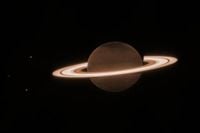On Thursday, April 17, 2025, stargazers will be treated to a rare celestial event as four planets align in what is being referred to as a planetary parade. The planets—Mercury, Venus, Neptune, and Saturn—will be visible in the early morning sky, particularly in the Southern Hemisphere, according to the website StarWalk.
The alignment is expected to take place just before sunrise, which is around 6 a.m. local time. For those in the Southern Hemisphere, this will provide an excellent opportunity to catch a glimpse of the planets positioned high above the eastern horizon. However, for observers in the Northern Hemisphere, the spectacle will be limited, with only Venus likely visible to the naked eye.
Neptune, the farthest of the four planets, presents a unique challenge for viewers. With a stellar magnitude of 7.9, it is the dimmest among the quartet. To see Neptune, enthusiasts will need binoculars or a telescope, as its light is too faint to be detected without assistance. In contrast, Venus will shine brightly, making it the standout planet in the lineup.
Elizabeth Warner, principal faculty specialist and observatory director at the University of Maryland, explained that while this event is often called an alignment, it’s more of a "dance of the planets." She likened the phenomenon to runners on a race track, where they appear to line up from a particular point of view as they move around the track. "If you watch the runners on a race track and you are in one of the lanes, you will see runners seemingly bunch up or line up from your POV occasionally as you move around the track," Warner stated.
John Conafay, CEO of Integrate Space, further elaborated on the concept of a planetary parade, stating, "A parade of planets, also sometimes referred to as a planetary alignment, is when several planets in our solar system appear to line up in the sky from our perspective here on Earth." He noted that these alignments occur due to the specific orbital speeds and paths of the planets around the sun.
This April’s parade follows similar events earlier this year, where six planets aligned in January and seven in February. The January alignment featured Venus, Mars, Jupiter, Saturn, Uranus, and Neptune, while February added Mercury to the mix. However, this month’s lineup will only consist of the four planets: Venus, Saturn, Mercury, and Neptune.
For those eager to witness this celestial event, it is recommended to wake up at least 90 minutes before sunrise, around 5 a.m. This will allow viewers to find a good vantage point with a clear eastern horizon. Warner advises watching for Venus, which will rise just before 5 a.m., appearing as a bright star low in the sky and gradually climbing higher.
As the morning progresses, Saturn will rise just before 5:30 a.m., followed by Mercury and Neptune. However, by this time, the dawn light may make it difficult to spot the latter two planets. Michael Shanahan, director of the Liberty Science Center Planetarium, pointed out that while Venus will be beautifully visible, Saturn and Mercury will be harder to see due to the brightness of the rising sun. He noted, "Saturn is still lost in the light of the rising sun, as is Mercury, and Neptune is always too faint to be seen without at least binoculars."
For those unsure whether they are looking at a star or a planet, Conafay provided some helpful tips. He explained that planets emit a steady light, while stars tend to twinkle due to atmospheric interference. Additionally, frequent stargazers will notice that planets move relative to stars over days or weeks, while stars remain fixed in their constellations.
In anticipation of the event, StarWalk recommends downloading its StarWalk 2 app, which includes a feature called "Planet Walk" that tracks the positions of each planet in the sky. This tool can help observers locate the planets more easily.
As excitement builds for the planetary parade, it serves as a reminder of the wonders of our solar system and the beauty of celestial events. Whether you’re an experienced astronomer or a casual stargazer, the alignment of Mercury, Venus, Neptune, and Saturn promises to be a delightful spectacle for all who take the time to look up.
So, mark your calendars and set your alarms! The early morning hours of April 17, 2025, will offer a unique opportunity to witness this planetary gathering. While the full parade may not be visible from every corner of the globe, the sight of Venus shining bright in the eastern sky will surely be a sight to behold.





